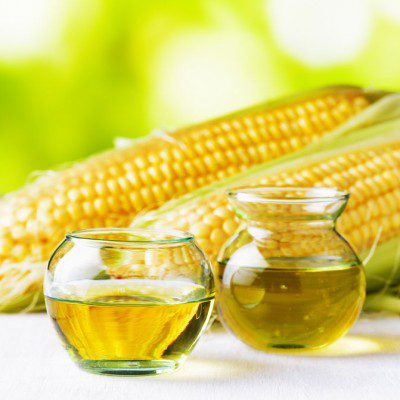[fusion_builder_container hundred_percent=”yes” overflow=”visible”][fusion_builder_row][fusion_builder_column type=”1_2″ last=”no” spacing=”yes” center_content=”no” hide_on_mobile=”no” background_color=”” background_image=”” background_repeat=”no-repeat” background_position=”left top” hover_type=”none” link=”” border_position=”all” border_size=”0px” border_color=”” border_style=”solid” padding=”” margin_top=”” margin_bottom=”0px” animation_type=”0″ animation_direction=”down” animation_speed=”0.1″ animation_offset=”” class=”” id=””][fusion_text]

Corn oil has a mild taste, is easily digestible, and adds nutritional value, so it is found in a variety of food and bakery products.
[/fusion_text][/fusion_builder_column][fusion_builder_column type=”1_2″ last=”yes” spacing=”yes” center_content=”no” hide_on_mobile=”no” background_color=”” background_image=”” background_repeat=”no-repeat” background_position=”left top” hover_type=”none” link=”” border_position=”all” border_size=”0px” border_color=”” border_style=”” padding=”” margin_top=”” margin_bottom=”” animation_type=”” animation_direction=”” animation_speed=”0.1″ animation_offset=”” class=”” id=””][fusion_text]
Corn Oil
What is Corn Oil?
Corn oil is a vegetable oil valued for its pleasing, nutty flavor, relatively low levels of saturated fatty acids, high levels of linoleic acid, an essential fatty acid, and low levels of linolenic acid.1
Due to its mild flavor, corn oil is popular as a cooking oil and is also used in salad dressings, shortenings, margarines, spreads, sauces and baked products.[/fusion_text][/fusion_builder_column][fusion_builder_column type=”1_1″ background_position=”left top” background_color=”” border_size=”” border_color=”” border_style=”solid” spacing=”yes” background_image=”” background_repeat=”no-repeat” padding=”” margin_top=”0px” margin_bottom=”0px” class=”” id=”” animation_type=”” animation_speed=”0.3″ animation_direction=”left” hide_on_mobile=”no” center_content=”no” min_height=”none”][fusion_text]
Origin
The wet milling process, invented by Thomas Kingsford in 1842, was critical to the origin of commercially manufactured oil and starch from corn. Prior to the advent of wet milling, starch was primarily made from wheat and potatoes and corn was not used as a source for either starch or oil.2 Wet milling led to many innovations in the uses for corn. By 1860, corn starch was being produced in small plants throughout the United States. Production volume varied throughout the latter part of the 1800’s but began a steady increase post-1900.
Corn oil was originally extracted toward the latter part of the 19th century for commercial cooking purposes. Following the success of corn starch a half century earlier, corn oil rose in popularity as a household ingredient in the mid-1900’s.
Composition
Corn oil is sold in a crude, intermediate-refined or a fully refined state. It has a pale yellow color which darkens during frying.3 Corn oil contains 52% linoleic acid which is an essential fatty acid not naturally created by the human body. It contains 31% oleic acid, 13% palmitic, 3% stearic and 1% linolenic acid. Foods low in linolenic acid are desirable for their resistance to rancidity. Corn oil also contains 14.84% vitamin E per 100 grams 4; it’s vitamin E content also helps protect it from oxidative rancidity.
Production
All commercially produced corn oil is obtained by the pressing of the corn germ and/or extracting the germ with hexane. 5 Other sources of corn oil include ground corn kernels and corn fiber. The United States is the largest producer of corn oil, followed by China; the U.S. is also the largest exporter of the oil. 6
Corn kernels contain high levels of starch – between 60 – 75% – and the wet milling process was created to efficiently isolate pure starch from corn kernels. The first corn wet mill in the United States began producing cornstarch in the mid-1800’s. During industrial scale wet milling, the non-starch portions of the kernel are separated into four groups; the corn germ group is the source of all commercial corn oil. The oil is typically removed from the wet-milled germ using a heating process, followed by mechanical expelling and finally hexane extraction.
Application
Corn oil is primarily used as a salad and cooking oil. It is easily digested and has a mild taste and is valued for its cooking properties as well as it’s nutritional value. Products containing corn oil include salad dressings, chips, sauces, bread, cookies, cereals and margarine, among others.
FDA Regulation
Corn oil – along with other vegetable oil blends and spreads – do not need to comply with the total fat disqualifying level set forth by the United States Food and Drug Administration. Numerous claims about the health benefits of corn oil have been made; more information about the regulation of those claims can be found at: http://www.fda.gov/food/guidanceregulation/guidancedocumentsregulatoryinformation/labelingnutrition/ucm064923.htm or http://www.fda.gov/downloads/Food/GuidanceRegulation/UCM265446.pdf.
References
- Ensminger, Audrey H. “Oils, Vegetable.”Foods & Nutrition Encyclopedia. Boca Raton: CRC, 1994. 1671. Web. 28 June 2016.
- “Corn Oil.” (n.d.): n. pag.Corn.org. Corn Refiners Association, 2006. Web. 28 June 2016.
- Vijayan, Jayadeep, David C. Slaughter, and R. Paul Singh. “Optical properties of corn oil during frying.” International Journal of Food Science & Technology 31.4 (1996).
- United States. Department of Agriculture. Agricultural Research Service. N.p.: n.p., n.d.National Nutrient Database for Standard Reference Release 28. Web. 28 June 2016.
- Moreau, Robert A., David B. Johnston, and Kevin B. Hicks. “A Comparison of the Levels of Lutein and Zeaxanthin in Corn Germ Oil, Corn Fiber Oil and Corn Kernel Oil.”United States Department of Agriculture. Springer AOCS, 9 Oct. 2007. Web. 28 June 2016.
- Gunstone, F. D.Vegetable Oils in Food Technology: Composition, Properties, and Uses. Osney Mead, Oxford: Blackwell, 2002. Print.
[/fusion_text][/fusion_builder_column][/fusion_builder_row][/fusion_builder_container]

